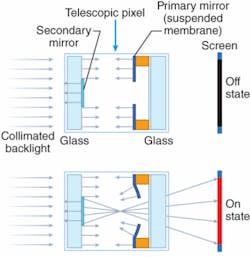The standard liquid-crystal display transmits only 5% to 10% of its backlighta large waste of energy and, for mobile devices, battery life. Researchers at Microsoft (Redmond, WA) and the University of Washington (Seattle, WA) have developed a high-efficiency telescopic-pixel design for flat-panel displays that experimentally transmits 36% of the backlight, with 56% possible after further optimization. The pixels’ rise and fall times are both under 0.63 ms, potentially allowing a color display to operate with sequential red-green-blue LEDs for illumination, thus requiring no filters of any kind.
Light enters each pixel through a glass plate with a central mirrored spot, then bounces off a deformable annular membrane primary mirror (see figure). When the primary is flat, light bounces toward the backlight (“off” state); when the primary is electrically deformed, light bounces from it and off the mirrored spot toward the viewer (“on” state). An important advantage of the geometry is that any electronic circuitry can be hidden behind the primary mirror so as not to reduce transmissionunlike all ordinary transmissive displays. Contact Anna L. Pyayt at [email protected].
